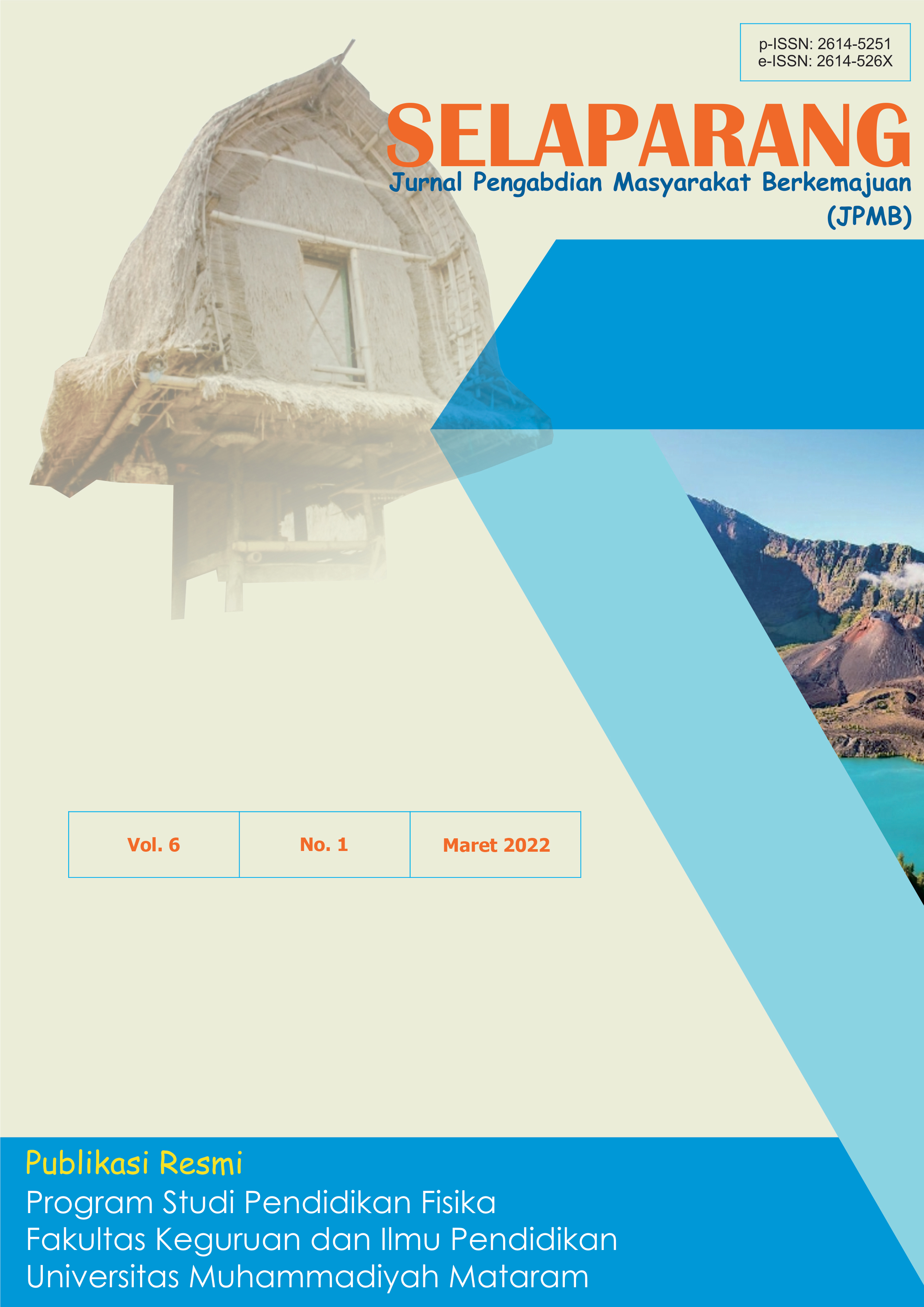APLIKASI HAND SANITIZER DARI BAHAN ALAMI SEBAGAI ANTISEPTIK TANGAN BAGI MASYARAKAT DESA DILE KECAMATAN DETUSOKO
DOI:
https://doi.org/10.31764/jpmb.v6i1.7746Keywords:
hand sanitizer, natural ingredients, antisepticAbstract
ABSTRAK
Covid-19 yang melanda dunia mengakibatkan pemerintah mengeluarkan peraturan patuhi protokol kesehatan yang salah satunya adalah menjaga kebersihan dengan mencuci tangan. Menjaga kebersihan adalah hal wajib yang harus selalu dilakukan oleh siapapun dan kapanpun. Salah satunya adalah menjaga kebersihan tangan, pasalnya tangan adalah bagian tubuh yang sangat rentan dengan mudah menjadi tempat bersarangnya virus, dan bakteri. Tangan sebagai organ tubuh yang sering kali berinteraksi, menyentuh dan dapat menjadi media penyebaran kuman, virus serta bakteri yang berbahaya. Cara yang dapat dilakukan masyarakat dengan menggunakan cairan hand sanitizer sebagai alat sterilisasi tangan agar terhindar dari wabah virus corona yang mematikan. Cairan hand sanitizer yang dibuat dari bahan alami yang ada dilingkungan tempat tinggal masyarakat, mudah didapat, lebih murah dan efektif. Tujuan dari kegiatan pengabdian pada masyarakat ini adalah untuk memberikan petunjuk pembuatan cairan hand sanitizer bagi masyarakat desa Dille sekaligus memanfaatkan bahan tradisional dalam pembuatannya. Bahan yang digunahkan adalah daun siri, jeruk nipis, lidah buaya, kemangi dan ketimun. Semua bahan yang disediakan dihaluskan, diperas diambil airnya kemudian dicampurkan. Setelah proses pembuatan dilakukan kemudian dikemas dalam botol dengan tiga varian rasa yaitu rasa timangi (campuran kemangi dan timun), rasa silibar (campuran daun siri dan lidah buaya), rasa jeriya (campuran jeruk nipis dan lidah buaya).Metode yang digunakan adalah penyuluhan sekaligus prantikum pada masyarakat desa Dille sejumlah 16 orang. Hasil evaluasi dari kelompok PKM adalah para peserta penyuluhan bisa mempraktekan dan menularkan kepada tetangga dan keluarga tentang cara pembuatan hand sanitizer untuk kesehatan Persentase keberhasilan baik softskil maupun hardskil mencapai 90% dan dari nilai ekonomisnya mencapai 100%, karena mereka menggunakan bahan alam dan botol bekas tanpa hasur membeli. Â
Â
Kata kunci: hand sanitizer; bahan alami; antiseptik
Â
ABSTRACT
The Covid-19 that hit the world has forced the government to issue regulations to comply with health protocols, one of which is maintaining cleanliness by washing hands. Maintaining cleanliness is a mandatory thing that must be done by anyone at any time. One of them is maintaining hand hygiene, because hands are a very vulnerable part of the body that easily becomes a nesting place for viruses and bacteria. Hands as organs of the body that often interact, touch and can be a medium for the spread of germs, viruses and harmful bacteria. The way that people can do is use hand sanitizer liquid as a hand sterilization tool to avoid the deadly corona virus outbreak. Hand sanitizer liquid made from natural ingredients that exist in the community's living environment, is easy to obtain, cheaper and effective. The purpose of this community service activity is to provide instructions for making hand sanitizer liquid for the people of Dille village while utilizing traditional materials in its manufacture. The ingredients used are siri leaves, lime, aloe vera, basil and cucumber. All the ingredients provided are mashed, squeezed, the water is taken and then mixed. After the manufacturing process is carried out, it is packaged in bottles with three flavors, namely timangi flavor (a mixture of basil and cucumber), silibar flavor (a mixture of siri leaves and aloe vera), jeriya flavor (a mixture of lime and aloe vera). The method used is counseling as well as practicum to the 16 people of Dille village community. The results of the evaluation from the PKM group were that the counseling participants could practice and transmit to their neighbors and family about how to make hand sanitizers for health. The percentage of success for both soft skills and hard skills reached 90% and the economic value reached 100%, because they used natural ingredients and used bottles without hasur buy.
Â
Keywords: hand sanitizer; natural ingredients; antiseptic
References
Agustin, V., & Gunawan, S. (2019). Uji fitokimia dan aktivitas antioksidan ekstrak mentimun (Cucumis sativus). In Tarumanagara Medical Journal (Vol. 1, Issue 2).
Apriasi, D., Suhardi, E., Jaenudin, D., Kimia Bahan Alam, L., & Penelitian Bioteknologi, P. (2015). EFEKTIVITAS ANTIBAKTERI EKSTRAK DAUN SIRIH (Piper betle Linn) TERHADAP Staphylococcus aureus ATCC 25923 (Vol. 5, Issue 2).
Asngad, A., Bagas, A. R., & Nopitasari. (2018). Kualitas Gel Pembersih Tangan (Handsanitizer) dari Ekstrak Batang Pisang dengan Penambahan Alkohol, Triklosan dan Gliserin yang Berbeda Dosisnya. Bioeksperimen, 4(2), 61–70. https://doi.org/10.23917/bioeksperimen.v4i1.2795
Maylia, N., & Cahyani, E. (2014). DAUN KEMANGI (OCINUM CANNUM) SEBAGAI ALTERNATIF PEMBUATAN HANDSANITIZIER BASIL LEAVES (OCINUM CANNUM) AS AN ALTERNATIVE OF HANDSANITIZIER. KEMAS, 9(2), 136–142. http://journal.unnes.ac.id/nju/index.php/kemas
Oktavia, L., Budiarti, T., Rahmawati, D., & Trisnowati, E. (2021). PEMANFAATAN TUMBUHAN SIRIH HIJAU SEBAGAI HAND SANITIZER ALAMI GUNA PENCEGAHAN COVID-19 DI DUSUN SUROJOYO. 2(1). https://id.priceprice.com/hand-sanitizer/
P, A. F., Ma’ruf, W. F., & Rianingsih, L. (2013). EFEKTIVITAS LIDAH BUAYA (Aloe vera) DI DALAM MEREDUKSI FORMALIN PADA FILLET IKAN BANDENG (Chanos chanos Forsk) SELAMA PENYIMPANAN SUHU DINGIN. Jurnal Pengolahan Dan Bioteknologi Hasil Perikanan, 2(3).
Sai, D., Sarma, K., Venkata, A., & Babu, S. (2011). Pharmacognostic and phytochemical studies of Ocimum americanum. J. Chem. Pharm. Res, 3(3), 337–347.
Widia Lauma, S., Pangemanan, D. H. C., Hutagalung, B. S. P., Studi, P., Dokter, P., Kedokteran, G. F., Fisiologi, B., & Kedokteran, F. (2015). UJI EFEKTIFITAS PERASAN AIR JERUK NIPIS (Citrus aurantifolia S) TERHADAP PERTUMBUHAN BAKTERI Staphylococcus aureus SECARA IN VITRO. In PHARMACONJurnal Ilmiah Farmasi-UNSRAT (Vol. 4, Issue 4).
Downloads
Published
Issue
Section
License
The copyright of the received article shall be assigned to the journal as the publisher of the journal. The intended copyright includes the right to publish the article in various forms (including reprints). The journal maintains the publishing rights to the published articles.

Selaparang : Jurnal Pengabdian Masyarakat Berkemajuan is licensed under a Creative Commons Attribution-ShareAlike 4.0 International License.

